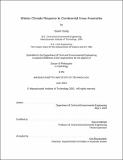| dc.contributor.advisor | Dara Entekhabi. | en_US |
| dc.contributor.author | Gong, Gavin, 1969- | en_US |
| dc.contributor.other | Massachusetts Institute of Technology. Dept. of Civil and Environmental Engineering. | en_US |
| dc.date.accessioned | 2005-05-19T15:17:40Z | |
| dc.date.available | 2005-05-19T15:17:40Z | |
| dc.date.copyright | 2003 | en_US |
| dc.date.issued | 2003 | en_US |
| dc.identifier.uri | http://hdl.handle.net/1721.1/16920 | |
| dc.description | Thesis (Ph. D.)--Massachusetts Institute of Technology, Dept. of Civil and Environmental Engineering, 2003. | en_US |
| dc.description | Includes bibliographical references (p. 137-142). | en_US |
| dc.description | This electronic version was submitted by the student author. The certified thesis is available in the Institute Archives and Special Collections. | en_US |
| dc.description.abstract | Climate variability has emerged in recent decades as an important field of geoscience research. A thorough understanding of the patterns and causes of climate variability is required to predict and prepare for upcoming climatic shifts, and also to accurately distill anthropogenic climate change signals from naturally occurring variations. In the extratropical Northern Hemisphere, regional climate patterns are strongly related to a hemispheric-scale mode of variability known as the Arctic Oscillation (AO). A major challenge for current climate variability studies is to predict the phase and magnitude of the AO, as it is a fundamental, internal mode of the atmosphere, but can nevertheless be triggered through a myriad of external perturbations. In this thesis the influence of one hypothesized external perturbation, continental-scale land surface snow anomalies, is investigated. Satellite observations of historical autumn-winter snow cover are used to develop model boundary conditions for a series of snow-forced numerical General Circulation Model (GCM) experiments. Realistic snow forcing over Siberia is found to exert a modulating influence on the winter season AO mode, which is consistent with observations. This winter climate response occurs via anatmospheric teleconnection pathway involving established stationary wave - mean flow interaction processes throughout the troposphere and stratosphere. The pathway is enabled by the specific and unique geographic and orographic conditions that exist in Siberia, and their role in the development of planetary waves. This model-simulated pathway provides a physical explanation for how regional land surface snow anomalies can influence hemispheric-scale winter climate. | en_US |
| dc.description.abstract | (cont.) The results of this study may potentially lead to improved seasonal predictions of winter climate, based on remotely-sensed Siberian snow conditions during the preceding autumn. The results also contribute to the field of land surface - atmosphere coupling by demonstrating interactions that occur outside of the warm season, and on broad continental and hemispheric scales. | en_US |
| dc.description.statementofresponsibility | by Gavin Gong. | en_US |
| dc.format.extent | 142 p. | en_US |
| dc.format.extent | 10730242 bytes | |
| dc.format.extent | 10729996 bytes | |
| dc.format.mimetype | application/pdf | |
| dc.format.mimetype | application/pdf | |
| dc.language.iso | eng | en_US |
| dc.publisher | Massachusetts Institute of Technology | en_US |
| dc.rights | M.I.T. theses are protected by copyright. They may be viewed from this source for any purpose, but reproduction or distribution in any format is prohibited without written permission. See provided URL for inquiries about permission. | en_US |
| dc.rights.uri | http://dspace.mit.edu/handle/1721.1/7582 | |
| dc.subject | Civil and Environmental Engineering. | en_US |
| dc.title | Winter climate response to continental snow anomalies | en_US |
| dc.type | Thesis | en_US |
| dc.description.degree | Ph.D. | en_US |
| dc.contributor.department | Massachusetts Institute of Technology. Department of Civil and Environmental Engineering | |
| dc.identifier.oclc | 52770036 | en_US |
